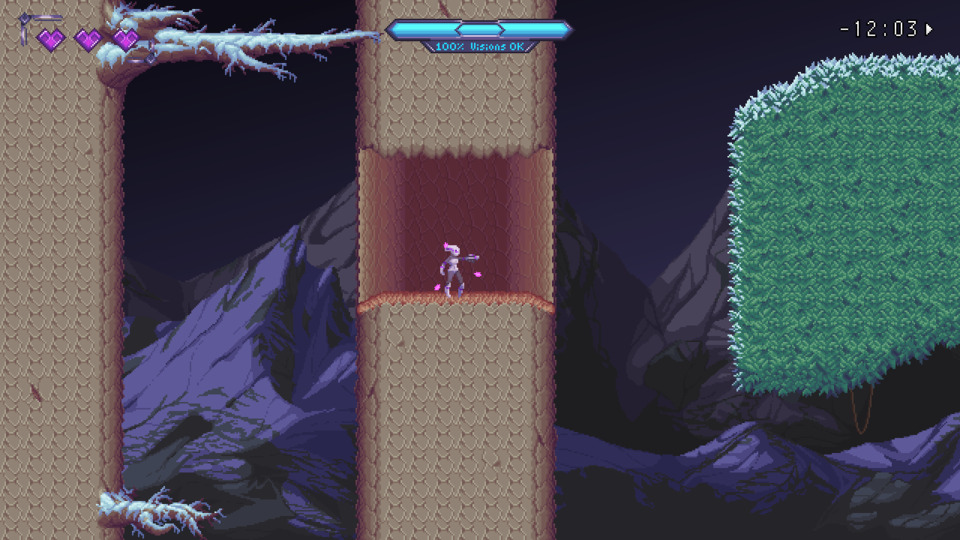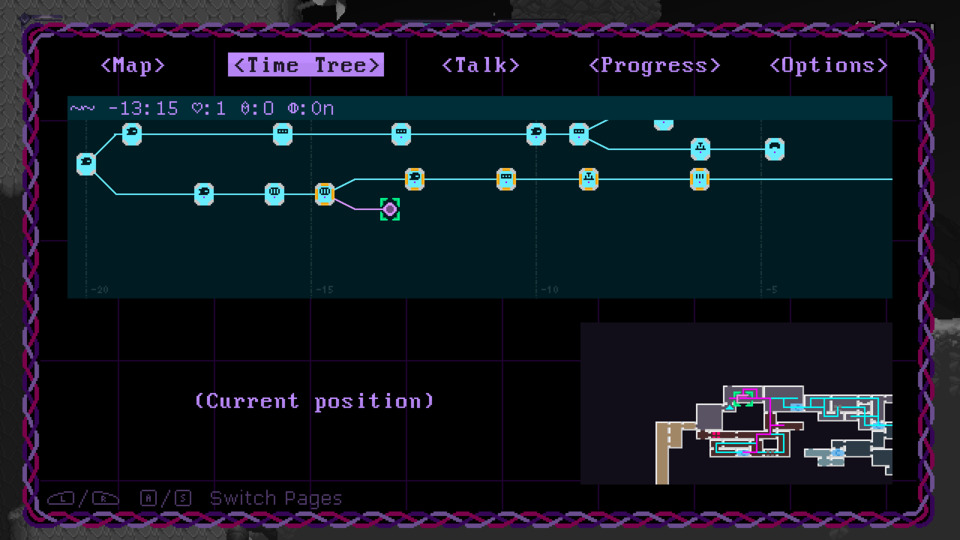Indie Game of the Week 198: Vision Soft Reset
By Mento 1 Comments

Plucking yet another of the many gratis explormers from the pile I received in the Itch.io Bundle for Racial Justice and Equality unexpectedly led to playing one of the most intriguing and genuinely cool examples of this genre since, well, Timespinner, with which it shares a focus on timeline manipulation. However, where Timespinner felt like it was designed with a historian or anthropologist mindset - letting the player discover a whole planet's culture and background by travelling across both its past and present - Vision Soft Reset feels instead like it was designed by an engineer or scientist. The logistics of time-line manipulation and precognition play much more significant roles in the mechanics of the gameplay, at the expense of a more elaborate story or characters.
The protagonist, Oracle, belongs to an alien species capable of seeing into the future. However, her current larval state is practically defenseless; a weakness that has been addressed after she was placed in an exosuit of unknown origin that her human partner Wally recovered for her. Oracle finds herself drawn to the mysterious planet from whence her exosuit was found, hoping to find more answers behind how the suit functions and where the Chozo-esque advanced alien race that once lived there may have disappeared off to. However, soon after landing, she discovers that the most impressive of these ancient technological marvels - a protective shield around the planet's molten core that prevents it from exploding out of control - is on the fritz and the planet only has twenty minutes before it becomes an inhospitable ball of magma. Finding out why the shield is so close to failure and who is responsible for its condition is going to take more than twenty minutes, but Oracle's gift of precognition allows her to see every hypothetical journey she may take from the starting location - in essence, giving her all the time she needs.

With anything regarding time travel, there's a bit of an uphill climb both in explaining how it works and justifying where and why it shouldn't, let alone getting to the part where you're able to effectively control the flow of time to your advantage. The game is built on time loops, but because you're preserving the memory of the protagonist every time you go back - as stated, it's less that you experienced it all but more that Oracle future-remembered how she... will experience it all... sorta? - there's certain things you're allowed to retain: chiefly, information. The many functions of Oracle's exosuit are largely unknown to her at first, but by acquiring data on what the suit can do she can remember these abilities for future loops: these data chips includes the usual explormer upgrades such as a mid-air dash (also effective as a double-jump, since you can dash upwards too); wall-running; a Super Metroid-esque speed booster; and various weapon upgrades capable of destroying specific barriers as well as foes. Each upgrade not only serves to make more of the map accessible, but to make it easier (and, more importantly, faster) to traverse the areas to which you've already been for any inevitable backtracking. Conversely, there are certain "physical" power-ups - mostly boosts to your max health and max "vision," which I'll explain in just a moment - which will not stay with you, and will instead return to their original locations should you reverse time to before you picked them up. Whenever you start a fresh loop, there's some deliberation as to whether or not you should take a more "scenic route" to the next objective in order to grab these upgrades along the way; given there's a few time-sensitive barriers here and there, that's not always feasible.
Oracle's "vision" is based on her intrinsic ability to see a snippet of the immediate future, usually about a second or so in advance. This allows her to predict enemy attacks, which appear first as grey silhouettes before happening for real, and also rewind time in case she gets hit: the former is a free, always-active passive skill as long as you have some vision stat remaining, while the latter siphons your vision stock away until it eventually empties (though the game will regenerate the last 25% of the bar, to ensure you always have enough to warp back to an earlier checkpoint in case you hit one of the game's few oubliettes). Having a healthy reserve of vision is best appreciated during the game's little arenas, where you have to fight off a few waves of enemies, and the boss battles, both of which can be tough to survive if you aren't able to rewind a few unlucky blows given the physical fragility of the heroine. Vision is a versatile resource you'll be relying upon a lot, between the big fights and some tricky platforming, and its few max upgrades are perhaps even more valuable than the max health ones if you've heading somewhere new and untested.

If this all sounds overly difficult and complicated, it... well, it is. Difficult, at least, as the complexities of the time-looping become more natural the more you play it thanks in part to some excellent UI work. Vision Soft Reset does not pull its punches when it comes to its challenges, occasionally feeling like a Super Metroid romhack intentionally built for the experts in the speedrunning community. Several challenges in the game require some exceptionally close timing. One example are these vines that harden into indestructible obsidian beyond a certain point in the timeline: if you find them after the moment they hardened, they'll have a specific number of flowers blooming on them to indicate how long ago it happened. With this knowledge, you're then tasked to plot a course that will get you to where (and when) they're vulnerable as quickly as possible. Other cases include opening a boss door by playing music on a series of "tone totems": totems that have carved holes that play a certain tune when the wind blows through them, but are initially plugged up with stoppers. To open that door, you need to unplug all the right ones in time for a sufficiently strong gust of wind to pass through them all, which comes only once (as far as I know) fairly early during the twenty minute timeline. Reliably hitting these deadlines requires a certain amount of expertise with the upgrades you acquire, in particular the finicky wall-running - you can hop between walls, but you have to hit the adjacent wall at an upwards angle for it to maintain the run - and the game's shinesparking equivalent, which requires a significant run-up first and then an uninterrupted sprint across even terrain.
If I had any trouble getting my head around the time-travelling though, the game alleviated it with its clear-cut UI, menus, and visual aids. In particular, a "time tree" flowchart accessible in the pause menu that gives you a rundown of your current timeline compared to previous ones you've created and abandoned in the past (or, in the future... you know what I mean). Each timeline is updated whenever you hit a checkpoint, which creates a node on the timeline you can always warp back/forwards to, and each of these node icons relay useful information such as where the checkpoint was (each one has a unique symbol identifier) and how many physical upgrades you were carrying at the time. Better yet, each node also has a smaller version of the mini-map that draws a path of where you've been, letting you know in no uncertain terms what you've accomplished up to that moment in that particular alternative timeline. The game world is fortunately small enough and has enough variety between areas that you're never completely lost or unsure where to progress, though like with any explormer it doesn't hurt to take the occasional external note (the game map tracks where physical upgrades are though, at least, if you ever decide to make detours for them).

There's a distinct risk that the above sounds like the scattershot ranting of a deranged mind, but Vision Soft Reset is far more approachable than I'm perhaps making it sound. It sets a uncommonly high challenge level as Indie explormers go, but a limited ability to rewind mistakes and preparing new routes that intersect with upgrades can mitigate it to some degree, as will the competent controls and the player's growing familiarity with the world and its layout as they explore. Graphically it's a little plain: the pixel artwork on smaller details is nicely intricate, but much of the wider landscape tends towards being featureless and barren. The soundtrack is suitably Metroid-y, though doesn't really stand out otherwise, and the plot is paper-thin and ends somewhat abruptly after the final boss battle. Even so, I think Vision Soft Reset is an ingenious, inspired take on a time-looping explormer that is worth checking out if you're a fan for any games of this genre that try to push the envelope in pure mechanical terms, especially if your favorites include either Timespinner or Axiom Verge.
Rating: 4 out of 5.
| < Back to 197: Agent A: A Puzzle in Disguise | The First 100 | > Forward to 199: Forager |
